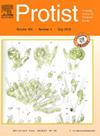Piercing the veil: A novel amoebozoan (Janelia veilia n. gen. n. sp.) reveals deep clades within Discosea through phylogenomics
IF 2.1
3区 生物学
Q4 MICROBIOLOGY
引用次数: 0
Abstract
Three major groups of primarily amoeboid taxa are present across Amoebozoa: Discosea, Evosea, and Tubulinea. While each of these groups were thought to have morphologically unique traits and members, the morphologic boundaries between each group have recently blurred. For example, it is demonstrated that several taxa in each group display monopodial limax amoebae, a characteristic most often associated with Tubulinea. Here we describe a novel discosean amoeba isolated from a freshwater pond, Janelia veilia n. gen. n. sp. Its cells have variable morphologies, but often display monopodial limax amoebae, with a unique trailing structure that appears to be derived from cellular material. In some cases, cells have conical pseudopodia or pointed pseudopodia. Using phylogenomics, we find that this taxon branches as sister to the recently described discosean Mycamoeba gemmipara and the sporocarpic protosteloid amoeba Microglomus paxillus, forming an order-level group we term Mycamoebida. Mycamoebida is fully supported as sister to Dermamoebida, together forming a subclass we term Dermelia. SSU rRNA phylogenies show that Janelia veilia n. gen. n. sp. is molecularly unique from any known organism, but branches with high support in a clade containing Mycamoeba gemmipara and several environmental sequences suggesting a larger diverse clade within Discosea.
揭开面纱:一种新的变形虫(Janelia veilia n. gen. n. sp.)通过系统基因组学揭示了Discosea内部的深层分支
主要变形虫类群有三个主要类群:盘状变形虫、进化变形虫和管状变形虫。虽然这些群体中的每一个都被认为在形态上有独特的特征和成员,但每一个群体之间的形态界限最近变得模糊了。例如,每个类群中都有几个类群表现出单足最大变形虫,这一特征通常与管线型有关。本文描述了一种从淡水池塘中分离出来的新型盘状变形虫,Janelia veilia n. gen. n. sp.它的细胞形态多样,但通常表现为单足极限变形虫,具有独特的尾随结构,似乎来源于细胞物质。在某些情况下,细胞有圆锥形或尖状伪足。利用系统基因组学,我们发现这个分类单元分支是最近被描述的盘状Mycamoeba gemmipara和孢子生的原柱状阿米巴Microglomus paxillus的姐妹,形成了一个我们称之为Mycamoebida的目级类群。Mycamoebida是Dermamoebida的姐妹,它们共同形成了一个亚类,我们称之为Dermelia。SSU rRNA系统发育表明,紫花紫花在分子上与任何已知的生物都是独特的,但在含有双足支原体的分支中具有高支持度,并且一些环境序列表明在Discosea中存在更大的多样性分支。
本文章由计算机程序翻译,如有差异,请以英文原文为准。
求助全文
约1分钟内获得全文
求助全文
来源期刊

Protist
生物-微生物学
CiteScore
3.60
自引率
4.00%
发文量
43
审稿时长
18.7 weeks
期刊介绍:
Protist is the international forum for reporting substantial and novel findings in any area of research on protists. The criteria for acceptance of manuscripts are scientific excellence, significance, and interest for a broad readership. Suitable subject areas include: molecular, cell and developmental biology, biochemistry, systematics and phylogeny, and ecology of protists. Both autotrophic and heterotrophic protists as well as parasites are covered. The journal publishes original papers, short historical perspectives and includes a news and views section.
 求助内容:
求助内容: 应助结果提醒方式:
应助结果提醒方式:


